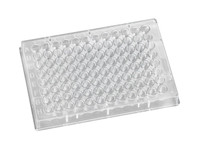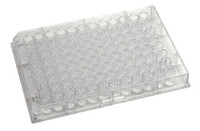96 Well ELISA Plates

96- and 384-Well Clear ELISA Plates
- Manufactured from high-clarity crystal polystyrene
- Flat-bottom design optimized for ELISA, absorbance, and colorimetric assays
- Compatible with automated liquid handlers and robotic platforms
- Working volumes: 350 µL (96-well) and 120 µL (384-well)
Chrom Tech’s 96- and 384-well assay plates deliver the optical clarity, consistency, and dimensional precision required for reliable ELISA, adsorption, absorbance, mixing, and general plate-based workflows. Each plate is injection-molded from crystal-clear polystyrene, ensuring low background, uniform well geometry, and highly reproducible spectrophotometric performance.
Designed for seamless integration into high-throughput screening and automated assay environments, these plates meet SBS/ANSI standards and maintain excellent chemical compatibility for routine biological and analytical applications. Their flat-bottom configuration supports accurate optical pathlengths, making them ideal for endpoint and kinetic measurements.
Whether you’re running ELISA kits, colorimetric assays, compound screening, or sample storage, Chrom Tech’s clear well plates provide a durable, economical solution with the performance and consistency required in modern analytical labs.
Looking for More 96-Well Plate Options?
View the complete lineup of polypropylene, deep-well, glass-insert, and specialty plate formats.
Explore All 96-Well PlatesKey Definitions
▸Crystal Polystyrene
A high-clarity polymer commonly used in assay plates due to its excellent optical properties and consistent surface treatment compatibility for ELISA workflows.
SBS/ANSI Format
Industry-standard microplate dimensions that ensure compatibility with liquid handlers, plate washers, readers, and robotic systems.
Flat-Bottom Well
A well geometry that provides a uniform optical pathlength, enabling accurate absorbance and ELISA measurements.
Working Volume
The recommended maximum liquid volume per well that maintains ideal pipetting accuracy and avoids splashing or cross-contamination.
96-Well Plate
A microplate with an 8×12 layout commonly used for ELISA, colorimetric assays, and general sample storage.
384-Well Plate
A higher-density 16×24 microplate designed for high-throughput screening and automated workflows where reagent conservation is essential.
Surface Treatment
A process (e.g., high-binding or medium-binding) applied to polystyrene to enhance protein adsorption for ELISA plate performance.
Clear Plate
A plate made from transparent polystyrene, specifically used for absorbance and colorimetric detection where optical clarity is critical.
Frequently Asked Questions
▸Are Chrom Tech ELISA plates compatible with automated liquid handling systems?
Yes. All 96- and 384-well plates follow SBS/ANSI footprint standards, ensuring seamless compatibility with robotic platforms, washers, and microplate readers.
What is the advantage of using clear polystyrene for ELISA?
Crystal-clear polystyrene provides excellent optical clarity and low background, making it ideal for absorbance-based assays where accurate optical density (OD) readings are essential.
Can these plates be surface-treated for higher protein binding?
Yes. Many plates are available with high-binding or medium-binding surface treatments to improve antigen or antibody adherence during ELISA workflows.
When should I choose a 96-well versus a 384-well plate?
Choose a 96-well plate for standard ELISA kits, routine colorimetric assays, or workflows requiring larger working volumes. Choose a 384-well plate for high-throughput screening or assays that require lower reagent consumption.
Are Chrom Tech ELISA plates sterile?
Most plates are non-sterile by default, but sterile packaging options are available depending on the specific SKU and application needs.
Do the plates support both endpoint and kinetic ELISA measurements?
Yes. The flat-bottom geometry and optical consistency allow accurate OD readings for both endpoint and time-based kinetic assays.




